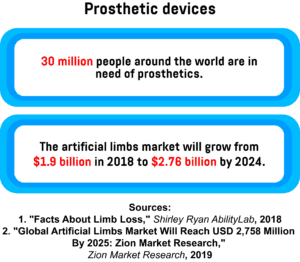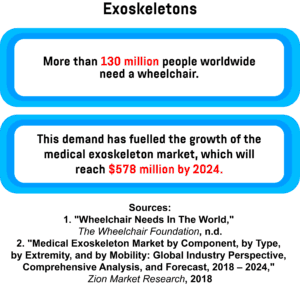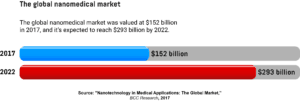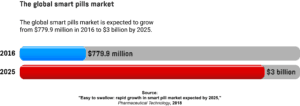- Developing a sense of touch in prosthetic arms
- Responsive artificial legs help users move with ease
- Exoskeletons allow disabled people to regain independence
- Existing methods of glucose monitoring are inconvenient – that’s why companies are designing more efficient solutions
- Mental disorders affect millions, but technology can help
- A team of scientists developed a smart wearable that can detect anxiety and depression in children
- Welcoming new solutions to the drug epidemic: treating addiction with smart tech and smart algorithms
- Nanobots could penetrate dense tissue
- Healing organs by injecting a new genetic code
- Smart pills enable easier health monitoring and drug delivery
- Overcoming regulatory hurdles
Tech innovations have transformed healthcare in the last several decades. New drugs and surgical procedures have helped doctors save countless lives, and thanks to research projects carried out by scientists worldwide, new discoveries are on the horizon. Groundbreaking medical solutions enable more efficient diagnosis, monitoring, and treatment of various medical conditions such as diabetes, cancer, and opioid addiction. And thanks to major research efforts at universities and companies across the world, it won’t take long before new medical practices reach mass adoption and change the lives of their users.
Developing a sense of touch in prosthetic arms
More than 30 million people globally are in need of prosthetics, and this figure is set to grow even further. Such trends have contributed to the growth of the artificial limbs market that’s expected to hit $2.76 billion by 2024. Tech advances help people with limb loss to easily overcome daily challenges. Instead of static devices that allow only limited movement, advances in robotics and artificial intelligence have enabled the development of prostheses that provide the wearer with a sense of touch.

An example of such an innovation is the high-tech LUKE Arm, developed by researchers at the University of Utah. The key part of this device is the Utah Slanted Electrode Array (USEA), which consists of 100 microelectrodes that read signals emitted by the user’s nerves in the forearm area. It can also send information to the brain using a proprietary algorithm, so that the wearer can feel tactile sensations. A volunteer wearing the device was even able to pick up eggs and grapes without breaking them. The team behind the project plans to start at-home trials soon, pending approval from the US Food and Drug Administration.
Engineers at Newcastle University in the UK have also developed an impressive prosthetic hand. The device is fitted with a camera that analyses the area in front of it, and then the system initiates movement to pick up the targeted object. This enables the wearer to effortlessly perform various actions, as everything happens “within a matter of milliseconds and ten times faster than any other limb currently on the market”, the university explains.
And a group of scientists from several European universities have enabled amputees to come close to a natural sense of touch. The cutting-edge bionic hand provides the wearer with the feeling of proprioception, the ability to know the position of our limbs without having to look at them. It enables the user to ascertain the shape and size of an object on a table without any visual clues. This is possible due to the flow of electric pulses that reach the brain through the amputee’s stump. Tactile sensations enabled by this device were so strong that volunteers could determine the size and shape of four objects with 75.5 per cent accuracy.
Responsive artificial legs help users move with ease
Major research efforts are underway to develop synthetic legs, too. Dr Tommaso Lenzi from the University of Utah’s Bionic Engineering Lab is testing a prosthetic leg that’s placed below the wearer’s knee. The device is dynamic and adapts its functioning to the user’s movements, such as climbing, sitting, and standing. It weighs only 800 grams and helps amputees to move with ease thanks to artificial intelligence and sensors that are responsive to external stimuli. Sarah Hood, a PhD candidate research student who works on the project, says that “we’re building robotic limb prostheses and powered exoskeletons that are more robust, and adaptive, to natural movement variability.”
Exoskeletons allow disabled people to regain independence
Many people take their ability to walk, run, and climb for granted. They go about their daily lives with ease and need no help to move around. But many others aren’t that lucky. Aging and various diseases like multiple sclerosis and stroke can prevent people from even standing up straight, let alone taking several steps.

The Wheelchair Foundation estimates that over 130 million people need a wheelchair. Being in a wheelchair can unfortunately cause infections in areas of the skin that are under constant pressure. These drawbacks and the demand for better mobility solutions fuelled the growth of the medical exoskeleton market that’s set to reach $578 million by 2024. Various products are already available, helping patients to improve the quality of their lives. And while wheelchairs can restore some degree of mobility, they don’t enable users to do any sort of natural movements. That’s why a growing number of companies are developing exoskeletons that empower people to lead a much more active life.
The Canadian company B-Temia, for instance, developed an exoskeleton called Keeogo that help users with various mobility and neurological conditions. For instance, people who suffer from knee and hip arthritis can use the system to offset weight from the knee, relieve pain, and support stable steps. Those battling multiple sclerosis benefit from additional support at the knee, an improved walking pattern, and being able to stay active for longer. And even people with Parkinson’s disease can use B-Temia’s exoskeletons to create bigger and smoother movement patterns.
Companies urged to design more efficient glucose monitoring solutions
Diabetes has become one of the biggest global health problems as well, prompting researchers to come up with more efficient solutions. It strikes people of all ages and ethnicities, and its prevalence has risen due to increased rates of obesity and a sedentary lifestyle. In fact, almost 630 million people will live with diabetes by 2045, and the problem has reached epidemic proportions. While there’s still no cure for this medical condition, managing blood sugar levels can help diabetics to live normal lives.
Diabetic patients typically rely on finger pricks to test their blood glucose levels. But while this procedure is widely used, it has some serious drawbacks. For instance, it doesn’t provide patients with continuous monitoring, and some people find the testing too painful, so they perform it less frequently than they should. That’s why various tech firms have developed continuous glucose monitoring (CGM) wearables that enable patients to effortlessly monitor their blood sugar levels and even deliver insulin doses.
Around 1.2 million diabetics use CGM devices across the world, and Dexcom G6 is one of the latest products in this field, developed by the American company Dexcom Inc., specialising in the development, manufacturing, and distribution of continuous glucose monitoring systems for diabetes management. The device consists of a sensor, a transmitter, a sensor applicator tool, a receiver, and a smartphone app. The user wears a hair-sized sensor wire on the abdomen, and the device monitors glucose levels in the fluid underneath the skin. The readings are transmitted to the smartphone via Bluetooth every five minutes, and users can easily view them on their smartphone. In case the sensor detects rapidly falling sugar levels, the app will alert the user to take appropriate action, such as eating high-sugar food. This way, diabetics can avoid falling into a condition known as hypoglycaemia and suffering from seizures or loss of consciousness.
Mental disorders affect millions, but technology can help
Another serious health problem is plaguing society. Mental disorders, though still a stigma, are becoming increasingly prevalent in modern society. And according to the latest statistics, depression and anxiety are snowballing, with more than 300 million people worldwide suffering from depression. That’s an alarming number, but what’s worse is that children are being diagnosed with these now ‘common’ mental issues at a very young age.
Being diagnosed and treated on time can help those suffering from anxiety and depression, especially as these disorders can significantly decrease quality of life and have detrimental consequences. In its worst form, mental illness is the leading cause of suicide, the rate of which has increased by a whopping 60 per cent in the past 45 years. Undetected and untreated, it can have devastating effects on people’s lives. Luckily, technology can help speed up diagnosis and tailor treatment to each patient.
A team of scientists developed a smart wearable that can detect anxiety and depression in children
Ryan McGinnis, a biomedical engineer at the University of Vermont, and his team created a wearable that can help screen children for anxiety and depression, and hopefully be able to detect these disorders at an early stage.
The team relied on a ‘mood induction task’, a “research method designed to elicit specific behaviors and feelings such as anxiety”. The research included 63 children, some already diagnosed with depression and/or anxiety, also known as internalising disorders. The participants of the study were led into a room with dim lights, with a covered terrarium at the back of the room, “while the facilitator gave scripted statements to build anticipation, such as ‘I have something to show you’ and ‘Let’s be quiet so it doesn’t wake up’”. The snake in the terrarium was in fact a toy, and when the facilitator took it out of its enclosure, he reassured the children that it’s fine to play with it.
During the experiment, the children were wearing a motion sensor powered by machine learning that was monitoring and analysing their movements. After analysis, the team was able to decipher which subjects were showing signs of internalising disorders with 81 per cent accuracy, outperforming standard parent questionnaires, the team claims.
Welcoming new solutions to the drug epidemic: treating addiction with smart tech and smart algorithms
Drug abuse destroys the lives of millions of people around the world. It leads to health issues, homelessness, and even death, and forces countries to pay substantial amounts of money for addiction treatment. The number of individuals who use drugs is rising, too, and it reached 271 million in 2017. Even though around 585,000 people died from drug use in the same year, only one in seven addicts receive the help they need. To prevent things from getting worse, scientists and companies are turning to cutting-edge technologies to treat addiction and prevent relapses during recovery.
The Addicaid app, for instance, uses artificial intelligence to predict when a user might relapse. Then, the software provides suggestions on how to stay sober and which phone numbers to call. Also, users benefit from various treatment suggestions and contact details of rehab centres, as well as the option to communicate with other recovering addicts and share their experiences.
Sober Grid is another useful app that’s hailed as the “world’s largest mobile sober community”. It provides users with resources and tips on how to stay sober during various stages of the recovery process. And together with researchers from the University of Pennsylvania, the company is developing a smart algorithm that analyses the language used by recovering addicts to predict relapses. Once that happens, the system offers support in the form of short mindfulness modules, or put the person in touch with trained coaches.
Opioids are an especially dangerous type of drug and have caused 110,000 deaths in 2017 alone. Heroin is the best known substance in this group, but many people use prescription opioids that are typically prescribed by doctors for pain relief. Opioid misuse can lead to coma, brain damage, and even death, which is why the US software firm hc1 developed a platform called Opioid Dashboard. It tracks opioid prescription volumes and detects misuse patterns, alerting authorities about warning signs in a certain county or ZIP code. This feature is useful for governments to track the impact of programs that aim to reduce opioid abuse.
Nanobots could penetrate dense tissue
Nanotechnology is the science of manipulating matter on the atomic or molecular scale to create tiny machines. These nanobots, usually one-billionth of a metre in size, could be used to fight cancer cells and repair our bodies. Also, they could eventually deliver drugs to targeted areas, diagnose diseases, and much more. Their potential has given rise to the global nanomedical market that’s expected to reach a value of $293.1 billion by 2022.
The growth of this industry is fuelled by vibrant research activities, with scientists from the Max Planck Institute for Intelligent Systems in Stuttgart, Germany, achieving an impressive breakthrough. They’ve developed nanobots that are 200 times smaller than the diameter of a human hair and can move through dense tissue, such as that found in the human eye, without damaging it. The first tests were carried out on a dissected pig’s eye that was populated with tens of thousands of nanobots. The scientists were then able to navigate these devices to reach the desired location by using a magnetic field. The same approach could potentially be applied to the human body to deliver drugs and fight various diseases with minimally-invasive treatments.
Researchers at Durham University in the UK are developing tumour-fighting nanobots. They successfully built nano-sized devices that can identify cancer cells and drill into them using light-activated motors. This technology was tested on live cells, including human prostate cancer cells, and human clinical trials might not be far away. Dr Robert Pal of Durham University says that these nanobots could “target cancer cells such as those in breast tumours and skin melanomas, including those that are resistant to existing chemotherapy”.
Healing organs by injecting a new genetic code
And if human organs are damaged for any reason, nanotechnology could help there as well. Scientists from Ohio State University’s Wexner Medical Center and College of Engineering are testing a device that can heal human cells with a single touch. Known as Tissue Nanotransfection (TNT), the system converts skin cells into any other type of cell by injecting them with a new genetic code. Doctors can then use the new cells to repair injured tissue and restore the function of organs, blood vessels, and nerve cells. Initial tests were carried out on brain-injured mice and it helped the animals to recover damaged nerve cells after a stroke. The procedure took less than a second, and the code was delivered using an almost imperceptible electrical charge. “We have shown that skin is a fertile land where we can grow the elements of any organ that is declining,” says Dr Chandan Sen, a co-author on the study and the director of Ohio State’s Center for Regenerative Medicine & Cell Based Therapies.
Attaching an antibody to a chemotherapy agent and turning cancer cells into fat
Cancer is one of the deadliest diseases on the planet. It claimed almost 10 million lives in 2018, and it shows no signs of slowing down. And despite the fact that nearly $140 billion is spent each year on cancer medication, most of the existing treatments don’t guarantee a positive outcome and are often too expensive for ordinary citizens. These challenges have prompted scientists across the world to intensify their research activities, which has led to a number of impressive innovations, bringing humanity a step closer to a cancer-free future.
Instead of injecting drugs into patients to fight cancer, scientists at the Francis Crick Institute in London took a different approach. They created a treatment that enhances the ability of cancer patients to fight the disease by implanting immune system cells of a healthy person into their bodies. Strengthening the body with cancer-fighting cells is expected to produce less side effects compared to the chemicals and drugs used in traditional therapies. The scientists expect that this method could increase the ten-year cancer survival rate by as much as 75 per cent, and human trials are set to begin in 2019.
Scientists from Georgia Tech and Emory University have also created an equally innovative solution for fighting cancer. A tube-shaped device called the Tumor Monorail is designed to ‘lure’ brain tumour cells into a container filled with a cancer-killing substance. The device was tested on rats and showed promising results, while the team hopes to start human trials in 2019. If successful, this technique could improve the abysmal brain cancer survival rates.
Smart pills enable easier health monitoring and drug delivery
The global smart pills market is growing and is set to reach $3 billion by 2025, up from $779.9 million in 2016. US-based institutions are leading the effort in this field, and the Massachusetts Institute of Technology (MIT) is no exception. Together with partners from the Draper Laboratory and Brigham and Women’s Hospital, MIT researchers developed a smart pill that can stay in a patient’s stomach for a month. During that time, it collects data such as body temperature and transmits it to the user’s smartphone through Bluetooth. It can also be modified to release drugs to ease symptoms of conditions like fever and keep track of various changes in the body such as infections and allergic reactions. The researchers also plan to equip the pill with sensors that can track heart rate and breathing. But for now, this device is still in the development phase and is yet to be commercially available.
The digital medicine firm Proteus managed to go one step further than MIT’s researchers. This US-based company created a sensor-embedded chemotherapy drug that, once taken, notifies the patient’s doctor and transmits data about the type and the size of the dose. Seven patients already use the service, and Proteus plans to involve 750 additional individuals into the program. Also, the cost of the treatment is no higher than regular chemotherapy drugs. Prior to this project, Proteus successfully developed sensor-embedded pills for patients with schizophrenia and bipolar disorder.
Overcoming regulatory hurdles
Smart pills can also help healthcare professionals to diagnose certain disorders. Australian researchers, for instance, used an electronic capsule to detect the levels of oxygen, hydrogen, and carbon dioxide in the large and small intestine of five participants. The data was then transmitted to an external device and helped doctors to monitor changes in their digestive tracts. Compared to endoscopy, pill-based monitoring of the gut is more effective and less invasive.
And while swallowable electronics are impressive, companies that operate in this field still have to comply with regulations. The US Food and Drug Administration (FDA), for instance, now requires smart pill manufacturers to specify whether their products are devices or pharmaceuticals, which can affect how strictly certain aspects of their applications are analysed. Also, the European Union (EU) has introduced changes to its Medical Device Regulation, which will result in more scrutiny during the review process for substance-based medical devices.
Scientific progress will pay off
Cancer, mental illness, and opioid addiction, among other, for now incurable, diseases, remain one of the 21st century’s greatest health challenges. Despite hundreds of billions of dollars poured into research, healthcare experts are yet to come up with effective and affordable treatment options. But things are starting to change, and a number of scientific breakthroughs have shed new light on the way cancer can be eliminated. We’re still far from a disease-free future, but the relentless work of researchers across the world will eventually pay off, and mutations that lead to cancer will cease to be a death sentence for millions of people.
Share via:




